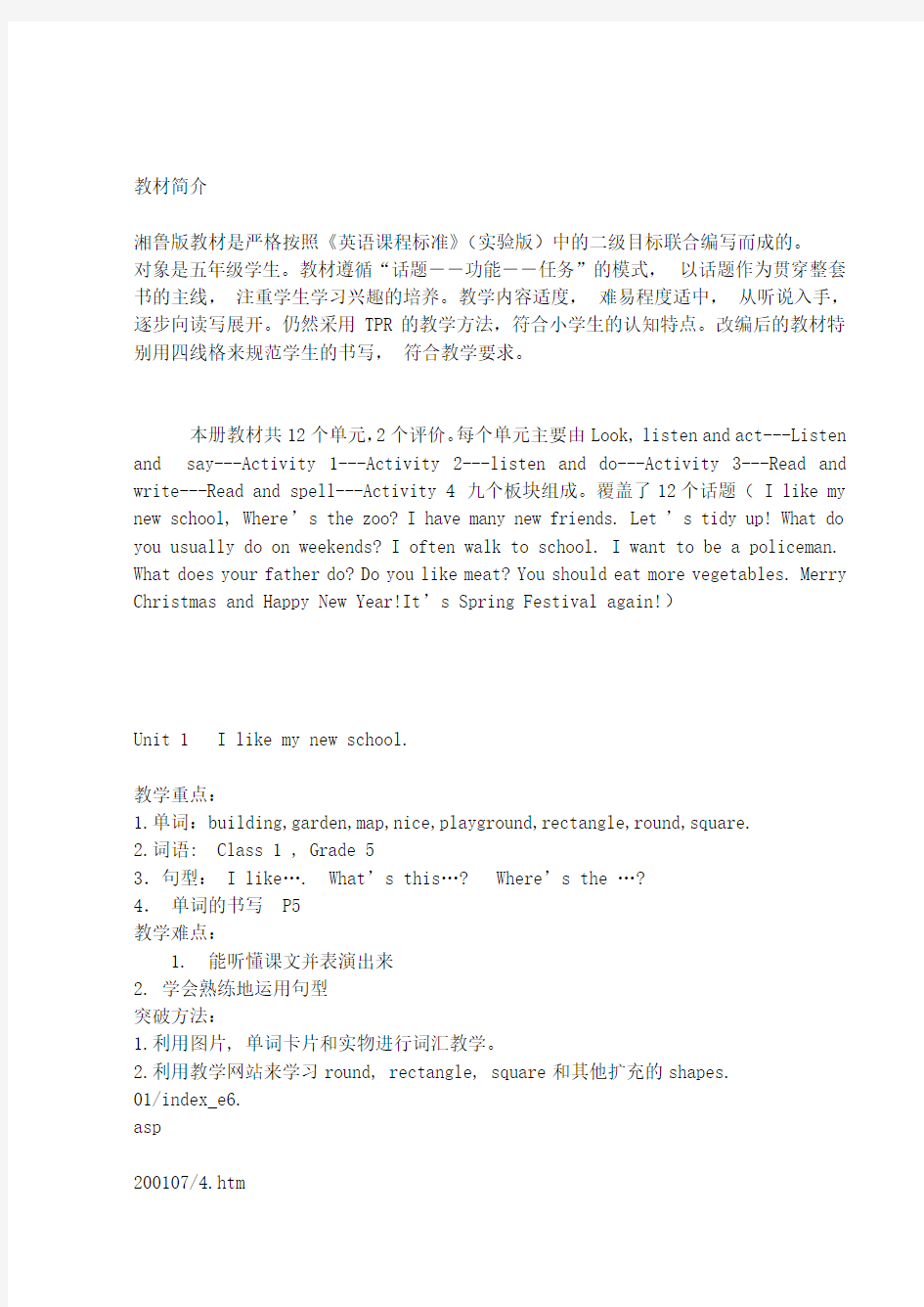

教材简介
湘鲁版教材是严格按照《英语课程标准》(实验版)中的二级目标联合编写而成的。
对象是五年级学生。教材遵循“话题――功能――任务”的模式,以话题作为贯穿整套书的主线,注重学生学习兴趣的培养。教学内容适度,难易程度适中,从听说入手,逐步向读写展开。仍然采用TPR的教学方法,符合小学生的认知特点。改编后的教材特别用四线格来规范学生的书写,符合教学要求。
本册教材共12个单元,2个评价。每个单元主要由Look, listen and act---Listen and say---Activity 1---Activity 2---listen and do---Activity 3---Read and write---Read and spell---Activity 4 九个板块组成。覆盖了12个话题( I like my new school, Where’s the zoo? I have many new friends. Let’s tidy up! What do you usually do on weekends? I often walk to school. I want to be a policeman. What does your father do? Do you like meat? You should eat more vegetables. Merry Christmas and Happy New Year!It’s Spring Festival again!)
Unit 1 I like my new school.
教学重点:
1.单词:building,garden,map,nice,playground,rectangle,round,square.
2.词语: Class 1 , Grade 5
3.句型: I like…. What’s this…? Where’s the …?
4.单词的书写 P5
教学难点:
1. 能听懂课文并表演出来
2. 学会熟练地运用句型
突破方法:
1.利用图片, 单词卡片和实物进行词汇教学。
2.利用教学网站来学习round, rectangle, square和其他扩充的shapes.
3. 利用chant 来复习巩固shapes
4. 提倡互动学习,培养合作精神:老师提供书本的图片由学生谈论:
What’s this rectangle? It’s my classroom.
Where’s the playground? The square.
教学后记;
Unit 2 Where's the zoo?
教学重点:
1.单词:straight, left, right, which, way, sign, live, will, halt,march
2.词语:go straight, turn left ,turn right, far away, close by ,
role play, capital city
3.句型:Which is the way to the…?
Where is…?
4. 单词的书写 P9
教学难点:
1. 表方位的词组: go straight, turn left, turn right
2.学生在实际生活灵活地运用,学会指路和准确地做答。
突破方法:
1.词汇教学:老师说单词,学生相应举起左手或右手;老师藏一只橡皮或其
它在某一手中,问“Where’s the pencil?”,让学生猜;带学生“开火车”跳兔子舞;为盲人指路
2.融会话教学于情景表演之中,师生一起在表演中教,在表演中练,在交际
活动中用
3.创造情景进行教学,让学生学会使用句型。
4.学生分组绘制简单的图,用英语进行练习问路。
教学后记;
Unit 3 I have many new friends.
教学重点:
1.单词: pretty, curl, curly, naughty, straight, turn, welcome
2.词语: guessing game, straight hair, curly hair, smiling face,
good-looking, make up, look good , look pretty, put on
3.句型:Who is he/she? Can you guess? He/She has… .
4. 单词的书写 P5 13
教学难点:
灵活地运用句型来准确地描绘他人的外表特点
突破方法:
1.先学习掌握单词和句型,再学习课文。
2.利用Guessing game 来猜学生身边发生的同学或老师,巩固句型。
3.利用多媒体网络:
4.歌曲可在每节课都放给学生听,在熟悉旋律后再作为课间休息让学生表演唱。
教学后记;
Unit 4 Let’s tidy up!
教学重点:
1.单词:bat, ping-pong, baseball, basketball, football, doll, Teddy bear,
keep, take, lost
2.词语: tidy up
3.句型: Whose … is it/this? It’s …’s. It’s his/hers/mine.
4. 单词的书写 P17
5. 字母组合-all在单词中的读音规则
教学难点:
1、句型教学。
2、名词性物主代词his/hers/mine的用法。
突破方法:
1.利用实物和身边的同学进行教学。
2.利用多媒体教学手段,让学生在直观环境下学习balls并复习旧识。
3.设计一些认领东西的游戏练习单词及句子。比如: Yes-No的游戏
教学后记;
Unit 5 What do you usually do on weekends?
教学重点:
1.单词:usually, sometimes, learn, weekend, weekday, painting, drawing, fishing, bookstore, survey
2.词组:Chinese paper-cuts, Chinese writing, find out, on weekends
3.句型:What do you usually do on weekends?
I usually learn Chinese writing.
4. 字母组合-ay在单词中的读音规则。
5.单词的书写 P21
教学难点:
1、单词教学和句型的熟练
2、联系实际, 来谈论自己平常做的事情
突破方法:
1.单词教学:利用图片和单词卡片让学生复习动作的词语,并学习新授词组。有意识
的强调painting, drawing, Chinese writing, fishing及其拼写方式。可采用大小声、猜猜他在说哪个单词、拼读单词比赛等游戏方法。
2.利用网站:
巩固动词和词组.
3.课文教学:先观察图片,听磁带,表演A部分的对话后自编对话。
4.发给学生调查表,让他们运用句型完成任务。
○○○○○○
1. painting 正
2. drawing 正 ̄
3. English Learning 正正
4. singing 正
5. dancing  ̄
6. Chinese Writing 正
7. fishing
教学后记;
Unit 6 I often walk to school.
教学重点:
1.单词:tick, form , walk, ask, diagram, sometime
2.词组: by bus, by car, by taxi, by train, by bike, on foot , each other school bus
3.句型:How do you usually go to school ? I often /usually….
4.单词的书写 P25
5.字母组合-ike在单词中的读音规则
教学难点:
单词和句型的掌握和运用
突破方法:
1.利用卡片、图片、游戏进行句型教学
2. 利用录音机让学生练习听力,然后跟读。
3.游戏活动:
a. 开火车: How do you usually go to school ? I often /usually….
b. 传声筒
4.任务型教学的完成:利用调查表练习句型,学以致用(可适当选择或更改)
Name: Class: Grade:
How do you go to school? usually often sometimes
1
2
3
4
5
How do you go to school/ shopping mall…?
Name By car By train By bus By bike By taxi On foot
S1
S2
S3
S4
5. Game:
教学后记:
Recycle 1
教学重难点:
阅读课文和练习
突破方法:
老师根据短文设计提问
学生听磁带做练习
让学生进行自我评价
Unit 7 I want to be a policeman.
教学重点:
1.单词:fireman, doctor, nurse, policeman, teacher, postman, fire,
save, people , interesting.
2.句型:What do you want to be? I want to be a ….
3. 单词的书写 P33
4. 字母组合-man在单词中的读音规则
教学难点:
运用所学内容表达愿望和理想。
突破方法:
1. 利用网站英语活跃课堂,可以课前课后随机播放: 2.asp> 2. 利用图片、头饰来设计不同的场景进行教学,使学生学会运用所学内容表达愿望和理想。 2.利用英语网站来进行单词教学并可以适当扩充: 3.玩抽纸条的游戏 Game: Pick and read 4. 课后作业: a. My dreams ――出黑板报:我的理想 b. Family Album( 照片,个人资料) 教学后记: Unit 8 What does your father do? 教学重点: 1.单词:company , computer, show, 2. 词组: ice-cream company, milk company, food company, computer company, newspaper company , telephone company, clothes company, name card, personal information 3.句型:What does you father do? He works in a … company. 4.单词的书写 P37 教学难点: 掌握并运用询问职业的句型。 突破方法: 1. 师生直接对话:T: What does your father/mother do? S1: He/She works in a … company. 产生信息沟后拓展词汇. 2.学生把父母的名片带到课堂中,相互谈论后做个调查表: S1: What does your father/mother do? S2: He/She works in a … company. S1 S2 S3 S4 Father Mother 通过小组活动巩固句型,培养合作能力 3. 练习介绍家庭成员:课前收集父母照片或图片,俩人一组练说: A : Look, this is my family photo. B: Who is it? A: He is my father. B: What does your father do? A: He is a teacher. he works in … 4. 在老师的指导下,学生动手制作名片 教学后记: Unit 9 Do you like meat? 教学重点: 1、单词:delicious, beef, dumpling, meat, menu, mutton, pork, noodle, vegetable 2. 词组:roast chicken, roast duck, take notes 3. 句型:a. Do you like…? Yes, I do. No, I don’t. b. What do you want/like to eat/drink? I want / like…. 4. 学会字母组合-ee/-ea在单词中的读音规则。 5. 读和写 P33 教学难点: 学会用英语来制作菜单并学会怎样点餐 突破方法: 1. 用多媒体网络展示各种食物,快速复习旧识,学习新词。 2.观察图片,然后听读 3. 在老师的指导下学生动手制作自己的菜单。然后分组自编对话进行情境对话。 4。 Listen and tick P39 表格练习 教学后记: Unit 10 You should eat more vegetable 教学重点: 1.单词:cabbage, carrot, cauliflower, tomato, potato, cucumber, salad, cooking, boil, yummy 2.词组:salad cream, shopping list , boiled egg, boiled potato 3.句型: You should /should not…. It’s good/bad for you. Yes, I think so. No, I don’t think so. 4.学会字母组合c-在单词中的读音规则。 5. 读和写 P33 教学难点: 学会运用句型表达意见或建议。 突破方法: 1. 制作多媒体课件快速复习food, fruits, vegetables 的单词。 2 学生制作Shopping List 3.利用多媒体创设情境突破句型的教学: You should eat more vegetables. It’s good for you. You should not read in the sun. It’s bad for you. 4.课后活动:小管家 教学后记: Unit 11 Mery Christmas and Happy New Year!